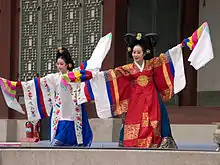Wonsam
The wonsam is a female ceremonial topcoat in hanbok, Korean traditional clothing. It was worn by queens, high-ranking court ladies, and royalty during the Joseon dynasty of Korea (1392-1910).[1] It is also called 'daeui' (大衣, big clothing), 'daesu' (大袖, wide sleeves) and 'jangsam' (長衫, long clothing).[2] The queen, princess consort, and consort to the first son of the crown prince wore it as a soryebok, a robe for small ceremonies, while wives of high officers and sanggung (court matrons) wore it as daeryebok, a robe for major ceremonies.[3]
| Wonsam | |
 Hwangwonsam (Yellow wonsam) | |
| Korean name | |
|---|---|
| Hangul | 원삼 |
| Hanja | 圓衫 |
| Revised Romanization | wonsam |
| McCune–Reischauer | wonsam |
The color and decorations of the garment around the chest, shoulders and back represent the wearer's rank.[1] For example, the color yellow was used for the wonsam of empresses, red for queens, jajeok (紫赤 magenta) for concubines and princess consorts, and green for princesses and women of the noble yangban class.[3][4] After being popularised by royalty, commoners were granted permission to wear wonsam at weddings only,[5] only the green wonsam.[1]
Varieties of silk were used as the fabric. Wonsam for winter were made with dan (緞), a thick silk with a glossy surface formed with a satin weave,[6] and wonsam for summer were made with sa (紗), a loosely woven silk.[7]
Unlike the po, an indigenous Korean overcoat with narrow sleeves, the wonsam was based on women’s half-sleeve Round collar robe that was worn in 15th century. After the Qing invasion of Joseon, its sleeves have gotten longer and wider. As an adaptation from the original model, the wonsam gradually evolved into a distinctive form characteristic of traditional Korean clothing.[4]
Today the wonsam is worn primarily in representations of Joseon royal ceremonies and as a wedding garment, and in a much simplified version when performing traditional Korean dances.[8][9]
Gallery
 Nokwonsam (green wonsam) for a princess[10]
Nokwonsam (green wonsam) for a princess[10] Nokwonsam exhibited at Asian Art Museum of San Francisco
Nokwonsam exhibited at Asian Art Museum of San Francisco Dancers in wonsam performing a Korean dance, Taepyeongmu
Dancers in wonsam performing a Korean dance, Taepyeongmu
See also
References
| Wikimedia Commons has media related to Wonsam. |
- "Official/Court clothing". Life in Korea.
- 원삼 (圓衫) (in Korean). Empas / Britannica.
- 원삼 (圓衫) (in Korean). Empas / EncyKorea.
- 원삼 (圓衫) (in Korean). Doosan Encyclopedia.
- Shim, Hwa-jin (2004). 우리옷 만들기 [Making our clothes] (in Korean). Seoul: Sungshin Women's University Press. p. 194.
- 단 (緞) (in Korean). Empas / Britannica.
- 사 (紗) (in Korean). Empas / EncyKorea.
- Hanbok Korean Overseas Information Service
- Dongnae Gomu(Dongnae Drum Dance) Busan Folklore Conservation Association
- Traditional Korean Wedding Dress to be Exhibited at Smithsonian Museum